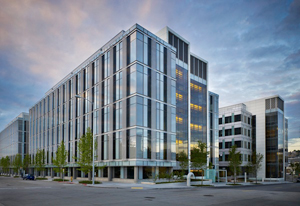In May, the Architectural Billings Index hit 47.2, its lowest point since June 2010. Yet in the midst of bleak national appraisals of the industry, Perkins+Will, headquartered in Chicago, seems to be going strong in the Pacific Northwest. This month, its Seattle office announced the acquisition of local firm Hinthorne Mott Architects, founded under the name Ruffcorn Mott Hinthorne Stine in 2004.

The acquisition will help the P+W Seattle office diversify its portfolio and boost its expertise in the healthcare and mixed-use sectors'a particular strength of Hinthorne Mott, according to Kay Kornovich, managing director of P+W's Seattle office. “We had been looking to expand for a number of years,” Kornovich says. “They're a well-known firm in Seattle'we just reached out and asked for a conversation.”
Hinthorne Mott brings four on-the-board projects to P+W, including a historic theater and public library in Alaska, and the Swedish True Family Women's Cancer Center in Seattle. Its 14 employees have all moved to the P+W office, and its two directors, Brad Hinthorne and Erik Mott, are now P+W associate principals. The merger increases the size of the P+W's Seattle office by a third, bringing its total number of employees to 46.
Hinthorne Mott's completed projects in the Seattle metropolitan area include the Institute for Health Metrics and Evaluation (2008), a global health research building connected to the University of Washington; Burien Town Square (2009), a mixed-use city hall and library; and the Station At Othello Park (April 2011), an apartment and retail complex built over the city's light rail line.
In the Pacific Northwest, P+W has been active in the higher education and corporate design spheres. The firm has designed research facilities, student unions, and libraries for clients including the University of Washington, Dendreon, the Institute for Systems Biology, and the Fred Hutchinson Cancer Research Center in Seattle. “We spent a lot of time together making sure we had similar values and cultures,” Kornovich says. “We both mutually saw the benefits, and we've gotten great responses from clients'they see this as a benefit as well.”
Currently, P+W's largest project is a mixed-use, 3,000-unit development on Puget Sound, where 41 acres are being converted into a new urban center. “It is a contaminated site, but a beautiful site to the west of the sound looking toward the mountains,” Kornovich says. “It is years and years of work.” In addition to the recent merger, Kornovich sees potential for further expansion of the Seattle office, especially in interior design, urban planning, and civic work. “We will continue to look at people and opportunities there,” she says.
Editor's Note: This story was updated on July 6, 2011.

Post a comment to this article
Report Abusive Comment